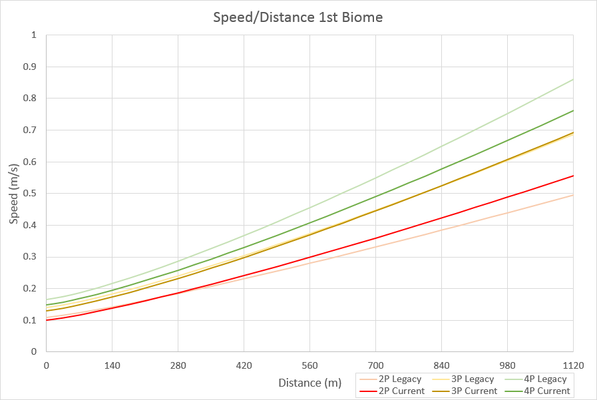Speed
Speed is the distance that the train travels in a second. The game measures distance using in-game meters. One meter equals one tile. For example if the train speed is .250 m/s the train advances one tile in four seconds.
Speedometer speed
The speed displayed at the top left corner of the screen is calculated based on the base speed of your train engine itself and the distance since the first station in the current biome. The speedometer increases every time a station is reached or skipped and increases or decreases proportionate to the number of players in your game. The train speed is automatically adjusted when connecting to and disconnecting from the game. The speedometer can be reset to the starting speed by heading to the next biome (upgrading the engine or entering the mine shaft).
Actual speed
Most of the time, the actual speed of the train is not the same as the one indicated by the speedometer. The actual speed of the train also heavily depends on the number of tracks placed in front of the train.
When there are 7 tracks placed ahead of the train, the actual speed of the train matches the speedometer.
The train speed is minimized when there are less than or equal to 3 tracks placed ahead of the train. At this time, the actual speed of the train can be as low as only 50% of the speedometer speed. This effect is reduced as the speedometer speed increases (for reference, the minimum speed is 80% of the speedometer speed when it reads 0.256m/s).
The train speed is maximized when there are more than 25 tracks placed ahead of the train. At this time, the actual speed of the train can be 3.2 times higher than the speedometer speed. This effect is reduced as the speedometer speed increases (for reference, the maximum speed is 1.86 times the speedometer speed when it reads 0.256m/s).
(Raw data Media:ActualTrainSpeedRawData.png)
Strategy
When the track layer needs to buy time for the teammates, the track layer should maintain the number of tracks ahead of the train as low as possible without risking crashing the train. Making loops is also effective, however, long loops can waste many resources, decreasing the team's efficiency.
The speed can also be slowed by using the Brake Wagon.
Stats
The following table shows the base speed of the engine in each biome as well as the player mining speed.
| Biome | Base speed (2 Players) | Base speed (3 Players) | Base speed (4 Players) | Mining speed |
|---|---|---|---|---|
| Plains | 0.100 | 0.130 | 0.150 | 0.500 |
| Desert | 0.116 | 0.148 | 0.169 | 0.533 |
| Snow | 0.131 | 0.165 | 0.187 | 0.600 |
| Underwater | 0.131 | 0.165 | 0.187 | 0.625 |
| Hell | 0.147 | 0.183 | 0.206 | 0.635 |
| Space | 0.162 | 0.200 | 0.224 | 0.704 |
| Mars | 0.147 | 0.183 | 0.206 | 0.784 |
The following graph shows the speed in relation to distance without engine upgrades in legacy and current builds with varying player count:
The formula for speed is a polynomial y = ax^2 + bx + c, where y is speed, and x is distance. The following table shows coefficients that fit the curves in the graph above quite closely:
| Player Count | a | b | c |
|---|---|---|---|
| 2 Players Current | 0.000000089397301 | 0.000315421241811 | 0.093460656990069 |
| 3 Players Current | 0.000000127407058 | 0.00037106459886 | 0.121522536287242 |
| 4 Players Current | 0.000000145257097 | 0.000396842226627 | 0.140355233002292 |
| 2 Players Legacy | 0.000000066574598 | 0.000275799322662 | 0.104916730328495 |
| 3 Players Legacy | 0.000000121705155 | 0.000363289157305 | 0.131692131398014 |
| 4 Players Legacy | 0.000000176765302 | 0.000437183289738 | 0.153868601986249 |

